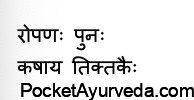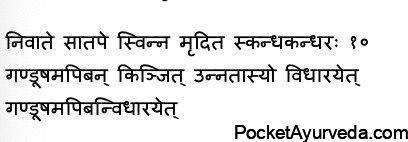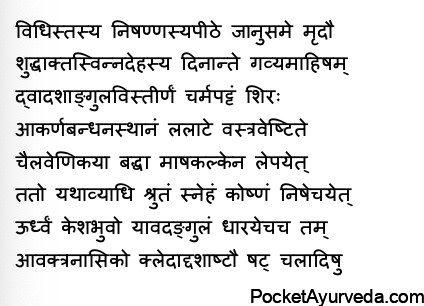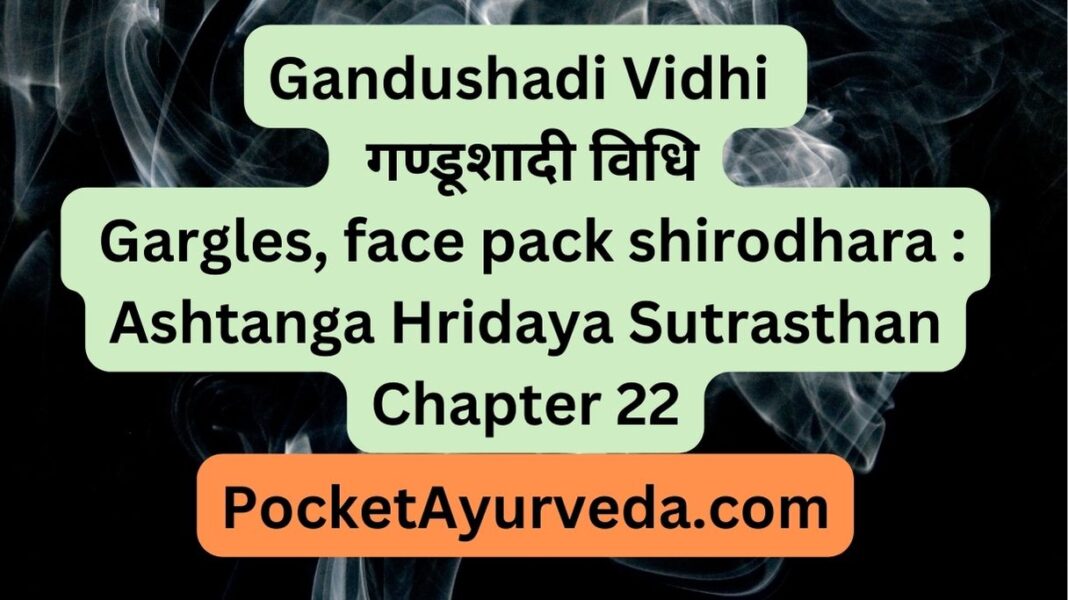in gandushadi vidhi we will discuss some oral, ear, and head therapies, their advantages, their procedure, etc. Acharya Vagbhata, the father of Vaidyapathi Simhagupta, writes the 22nd chapter in Ashtanga Hrudaya Sutrasthana. The name of Gandushadi Vidhi Adhyaya knows the chapter because it begins with an explanation of Gandusha, mouth gargling.
Notice: Gandusha is a treatment procedure involving the patient holding the medicine’s liquid in his mouth to the maximum over a certain time frame.
Gandusha Types – Full volume mouth gargling prakara


Gandusha is one of four types of Gandusha, which are namely,
1.Snigdha – Lubricating, using fats and oils – for Vata balance disorder. 2.Shamana palliative used to treat Pitta imbalance disorder
3.Shodhana purifying the lungs – to treat Kapha imbalance disorder
4.Ropana – healing.
Snigdha Gandusha


Snigdha Gandusha
Lubricating the full mouth gargle is made possible by using oils that are processed using salt herbs of sweet and sour rasa.
Shamana Gandusha


Shamana Gandusha
A soothing full-mouth gargle is performed using herbs with bitter, astringent, and sweet rasa. (Tikta,Kashaya,Madhura)
Shodhana Gandusha


Shodhana Gandusha
Purifying full gargle contains herbs with bitter, sweet, spicy, and salty tastes and with Ushna – hot property.
Ropana Gandusha


Ropana Gandusha
A full and healing gargle that is made of herbs that are bitter and astringent.
Gandusha material – liquids that are utilized in Gandusha


Gandusha material – liquids used in Gandusha
Fats – oil, ghee, etc., milk,
Honey mixed with water
Shukta is fermented gruel
Madya – wine,
Mamsarasa is the juice of a piece of meat,
Mutra is the urine of animals or
Dhanyamla is a grain wash fermented overnight; the liquids are widely used in Gandusha.
The liquids are mixed with the”kalka” (herbal paste)
The liquids can be cooked or raw.
The liquids must be pleasant to hold and touch within the mouth.
Tilakalkodaka is a paste of sesame seeds mixed with water
In conditions like
Dantaharsha: tingling sensation in the teeth
Dantachala – teeth that shake, and
Mouth disease caused by Vata Gandusha and water mixed with sesame seeds, whether cold or lukewarm, can be beneficial. 5
Taila (sesame oil), Mamsarasa (meat soup), Ghrita (ghee), Ksheera (cow milk)


For everyday use, sesame oil or soup made from meat is a good choice. Gandusha is for burning and ulcers.


If there is a general or local feeling of burning (Daha) ulceration, injuries caused by foreign bodies or poisonous burns, and the alkalis (Kshara), or burns caused by fire, it’s best to use either ghee or milk. 3 – 6.


Honey – Placing honey in your mouth eliminates the taste of your mouth. It heals ulcers fast and relieves burning sensations and thirst. 7.


Holding Dhanyamla – a fermented grain wash in the mouth eliminates taste and dirt (of the tongue and teeth) and bad odor.


The same Dhanyamla, with no salt when taken cold, is the best method to remove dryness in the mouth.


Holding Ksharambu, which is water with alkalies inside the mouth, rapidly helps break up Kapha’s buildup.
Hot water gargling


Warm water held in a comfortable position will help remove a sting and cleanse of mouth. 8 – 9.
Gandusha Vidhi – Gargling Procedure


The patient should be in a spot free of air (Nivata) but in the sun (Sa Aatapa). The neck and shoulders are to be stretched and stimulated;
While his face is slightly lifted,


He should keep that liquid until the mouth is filled with Kapha or until the eyes and nose begin exuding liquid. 10 – 11.
Differences between Kavala and Gandusha


Difference between Kavala and Gandusha
The mouth is filled with liquids completely, not allowing any movement within Gandusha.
Kavala injects liquid into the mouth and then moves it around with gargling over a specific period.
Kavala mouth gargles


Kavala – mouth gargles
Neck Head or ears, mouth, and eye, Praseka excessive salivation disorders of the throat, dryness of the mouth, nausea
Tandra – stupor, Aruchi Anorexia and
Peenasa – rhinitis is curable through Kavala mouth gargles. 12.
Pratisarana is a mouthwash that coats the mouth with herbs


Pratisarana – coating the mouth with herbs
Pratisarana is the practice of applying herbal paste to the inside of the mouth using the fingers – it comes in three varieties, namely,
Kalka – in the form of a paste
Rasakriya – a solidified decoction
Curna – powder
It is recommended to do this in cases of Kapha source using the same herbs recommended for Gandusha. 13.
Mukhalepa application of herbal paste on the face, facial creams , face packs


Mukhalepa application of herbal paste on the face, facial creams
Mukhalepa Application of a paste of herbal extracts on the face. It comes in three types: Doshaha – eliminating Doshas
Vishaha – eliminating poison and
Varnakara – improving complexion. 14.


It is recommended to apply it warm to treat Vata as well as Kapha; for Pitta deficiency, it must be cold.
Its three thickness
Mukhalepa Thickness – face pack thickness


Minimum – 1/4th Angula (Finger breadth) Medium – 1/3 Angula
Maximum 1.5 – 1 Angula thick.


It is best to let it be left to dry. If it becomes dry, it alters the color of the skin; therefore, it must be removed when it is dry. In the removal process, it must be kept moist to facilitate removal.
Following the removal of the sock, a light oil massage is recommended. 16.
Things to be aware while applying face pack – Mukhalepa


The patient should stay away from day sleeping, talking for long periods, and being exposed to heat and sunlight, sadness and anger during the process.
Contraindication of applying face pack


Contraindication of Mukhalepa
It should not be given to people with
Peenasa – rhinitis,
Ajeerna – indigestion,
Nasya therapy – those who have been treated with Nasya treatment, Hanugraha Locked jaw
Aruchi – anorexia
Jagarana is a sleep loss.
Benefits of Face packs, face creams – Mukhalepa


Benefits of Mukhalepa
If the procedure is done properly; it can cure
Akalapalita is early graying in hair ` Vyanga is a discolored patch on the face Vali – wrinkles
Timira is blindness,
Neelika blue vision (a kind of blindness) 17-18.
Face pack according to season
This set of seven recipes is perfect in the six season, beginning with Hemanta -(early the winger).
- In Hemanta (early winter) Marrow of Kola and the root Vrisha (Vasa — Adhatoda vasica), Sabara, and Gaurasarsapa (White mustard).
- For Shishira (winter) – Root of Simhi, Krisna tila (black sesame), the bark of Darvi, and Dehusked Yava (barley).
- For Vasantha (Spring) – Root of Darbha, Hima; Usheera, Shirisha, Mishi, and Tandula (rice grains)
- For Greeshma (summer) – Kumuda, Utpala, Kalhara, Durva, Madhuka, and Chandana (Sandalwood).
- Varsha (Rainy season) – Kaliyaka, Tila, Usira, Mamsi, Tagara and Padmaka.
- Sharath (Autumn) – Talisa, Gundra, Pundrahva, Yasti, Kasa, Nata, and Aguru. 19 – 21.


Suppose you are accustomed to applying a paste of herbal extracts over the facial area. In that case, the eye gets sharper, and the face is always glowing, soft, and radiant, resembling the lotus flower. 22.
Murdha Taila – Treatment with oil on the head


Murdha Taila – Oil treatment of the head
Murdha Taila – oil application to the head is one of four kinds.
Shiro Abhyanga by smearing oil on the skin and a gentle massage
Shiro Pariseka– pouring oil in a continuous stream,
Shiro Pichu – keep the cloth soaked in oil for the entire scalp
Shiro Basti Makes the oil sit up on the head using the compound.
Each subsequent one is more efficient. This means that Shirobasti can be the best of all four.
Shiro Abhyanga


Shiro Abhyanga
Oil and gentle massages should be applied for itching and dryness.
Shirodhara – Shiro Pariseka


Shiro Pariseka
applying oil in the form of a thin stream can help with scalp ulcers, headaches, burning sensations, suppurations, and wounds on the scalp. It’s also called Shirodhara.
Shiro Pichu


Shiro Pichu
cotton swabs or oil-soaked cloth swabs that are rubbed on the scalp. They help prevent the fall of hairs, crack or cracking of the skin, and burning sensation.
Shiro Basti


Shiro Basti
causing the oil to sit on the head in instances of Netrasthamba absence of movement of the eyeball Prasupti and loss of sensation of the scalp Ardita facial palsy Jagara – sleep loss,
Nasa Asya Shosha has dryness in the mouth and nose, and Timira is blind.
Daruna Shiroroga – terrible diseases in the brain. 23 – 26.
Shirobasti Vidhi – Shirobasti Procedure




Shirobasti Vidhi – Shirobasti Procedure
Someone who is cleansed by Vamana, Virechana, etc. It is recommended to massage gently with oil before being given mild swedana.
After close to the end of the day (evening), it must be forced to sit on a stool that is the same height as the knee and a strap of leather made of the leather of buffalo or cow or buffalo, twelve Angula in width ( 8 to 9 inches) and about the size of the head’s circumference should be slung around the head just above the ears, and covered with an afghan over the forehead and secured tightly by a thread.
The joints and spaces between them are to be filled with an oil-based paste made of black grain flour to avoid loss of oil. Then, the medicated oil that is prescribed for the condition must be poured onto the head at lukewarm temperatures until an elevation of 1 Angula on the scalp.
Maatrakala – the time required to hold the medicine in shiro bsti


It is recommended to hold it until the release of fluid occurs in the nose and mouth or for a time in the 10,000 Matra Kala to achieve Vata
8,000 Matra Kala for Pitta and
6,000 Matra Kala for Kapha
1 Matra Kala is the time it takes to blink the eye a few times. For a healthy individual, this is 1,000 Matra Kala.
Approx 45 minutes is practiced now a days.
The postoperative process of Shiro Basti – Shiro Basti paschat Karma


After this time, the shoulders, etc., should be massaged after removing the oil on the head. Seven days is the most effective time for this therapy. 27-31.
Karna Purana – filling oil into the ears


Karna Purana – filling the ears with oil
The ears must be filled with medicated fat or oil, and the ear’s ring massaged until discomfort or disease and for a time of 1,000 Matra Kala in cases of healthy people. 32.
Karna purana time – Matra Kala of karna purana


The time needed for the hand’s finger to turn around the right knee or for the time needed to close and open the eyelids at once is referred to as the term Matrakala. 33.
Benefits of oiling the head – Murdhataila Phala


Benefits of oiling of the head – Murdhataila Phala
Oiling of the scalp stops or treats graying, falling, and matting of hair and skin cracking on the scalp. Conditions that affect the head due to Vata imbalance, which results in the clarity of the sense organs, and strengthens the jaw, voice, and head. 34.
This concludes the chapter Gandushadi Vidhi, the 22nd chapter in Sutrasthana of Astanga Hridaya.
FAQ’s of Gandusha Vidhi Adhyaya
what is gandusha?
It is a treatment in which patient holding the medicine’s liquid in his mouth to the maximum till water comes out from eyes and nose.
which are the types of gandusha?
1.snigdha,2.shamana,3.shodhana,4.ropana
what are the dravya used for gandusha?
fats, honey, shukta, madya, mamsarasa, mutra, dhanyamla
which material is used for gandusha daily?
Tila Taila.
what is the difference between kavala and gandusha?
gandusha is holding liquid in mouth without any movement and kavala is with movement.
what are the indications of kavala?
praseka,dryness of mouth,nausea,tandra,aruchi,peenasa
what is pratisarana?
pratisarana is coating with herbal paste inside mouth.
what are the varieties of pratisarana?
kalka,rasakriya and churna are used in pratisarana
what are the benefits of applying face packs?
Eliminating dosha, eliminating poison and improving complexion.
what is the ideal thickness of face pack?
Minimum – 1/4th Angula (Finger breadth) Medium – 1/3 Angula
Maximum 1.5 – 1 Angula thick.how face pack is applied and removed according to ayurveda?
applied and left to dry once become dry it should be removed (after mosit with water) and light oil massage is to be done after removing facepack.
what should be avoided when applying face pack?
The patient should stay away from day sleeping, talking for long periods, and being exposed to heat and sunlight, sadness and anger during the process.
what are the contraindications of applying face pack
peenasa,ajeerna,nasya,hanugraha,aruchi,jagarana
what are the benefits of face packs, face creams?
beneficial in early graying in hair ,discolored patch on the face,wrinkles,blindness,
what are the types of murdha taila?
shiro abhyanga, shiro pariseka, shiro pichu and shiro basti




